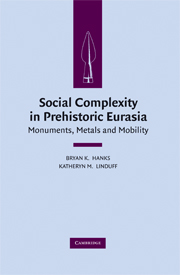Book contents
- Frontmatter
- Contents
- Contributors
- Foreword: From Myth to Method: Advances in the Archaeology of the Eurasian Steppe
- CHAPTER 1 Introduction: Reconsidering Steppe Social Complexity within World Prehistory
- PART ONE FRAMING COMPLEXITY
- CHAPTER 2 Introduction
- CHAPTER 3 Differentiated Landscapes and Non-uniform Complexity among Bronze Age Societies of the Eurasian Steppe
- CHAPTER 4 The Sintashta Genesis: The Roles of Climate Change, Warfare, and Long-Distance Trade
- CHAPTER 5 Settlements and Cemeteries of the Bronze Age of the Urals: The Potential for Reconstructing Early Social Dynamics
- CHAPTER 6 The Maikop Singularity: The Unequal Accumulation of Wealth on the Bronze Age Eurasian Steppe?
- PART TWO MINING, METALLURGY, AND TRADE
- PART THREE FRONTIERS AND BORDER DYNAMICS
- PART FOUR SOCIAL POWER, MONUMENTALITY, AND MOBILITY
- Index
CHAPTER 4 - The Sintashta Genesis: The Roles of Climate Change, Warfare, and Long-Distance Trade
from PART ONE - FRAMING COMPLEXITY
Published online by Cambridge University Press: 26 January 2010
- Frontmatter
- Contents
- Contributors
- Foreword: From Myth to Method: Advances in the Archaeology of the Eurasian Steppe
- CHAPTER 1 Introduction: Reconsidering Steppe Social Complexity within World Prehistory
- PART ONE FRAMING COMPLEXITY
- CHAPTER 2 Introduction
- CHAPTER 3 Differentiated Landscapes and Non-uniform Complexity among Bronze Age Societies of the Eurasian Steppe
- CHAPTER 4 The Sintashta Genesis: The Roles of Climate Change, Warfare, and Long-Distance Trade
- CHAPTER 5 Settlements and Cemeteries of the Bronze Age of the Urals: The Potential for Reconstructing Early Social Dynamics
- CHAPTER 6 The Maikop Singularity: The Unequal Accumulation of Wealth on the Bronze Age Eurasian Steppe?
- PART TWO MINING, METALLURGY, AND TRADE
- PART THREE FRONTIERS AND BORDER DYNAMICS
- PART FOUR SOCIAL POWER, MONUMENTALITY, AND MOBILITY
- Index
Summary
Introduction
Recent studies by Di Cosmo (1999, 2002) and Vehik (2002) have emphasized the transformational political effects of intertribal warfare in arid grasslands on two continents. Intensified warfare in both places encouraged greater political complexity, hierarchy, and elite-centered, distance-trading activities. This chapter argues that intensified warfare and long-distance trade played powerful roles in the origins of the Sintashta culture. Sintashta is defined by a group of fortified settlements and cemeteries dated about 2100–1800 bce (calibrated) in the northern Eurasian steppe between the upper Ural and upper Tobol rivers southeast of the Ural Mountains. Outside the settlements were cemeteries that yielded whole-horse sacrifices, chariots, and many weapons. Inside the settlements, almost every excavated house yielded copper slag and remains of furnaces or intensely burned hearths. The metal was copper or arsenical bronze, usually in alloys of 1–2.5% arsenic. Pieces of crucibles were placed in two graves at Krivoe Ozero (Vinogradov 2003: 172), and broken casting molds were recovered from the Arkaim settlement. An estimated 6,000 tons of quartzitic rock bearing 2–3% copper was mined from the single documented mining site of Vorovskaya Yama east of the upper Ural River (Grigoriev 2002: 84; Zaikov, Zdanovich, and Yuminov 1995). The surprising evidence for metallurgical production inside every excavated structure suggests that the Sintashta settlements were the focus of intense metalworking activities, although the scale and organization of metal production is not well understood either within or between them (see Hanks, Chapter 9 in this volume).
- Type
- Chapter
- Information
- Social Complexity in Prehistoric EurasiaMonuments, Metals and Mobility, pp. 47 - 73Publisher: Cambridge University PressPrint publication year: 2009
- 20
- Cited by

